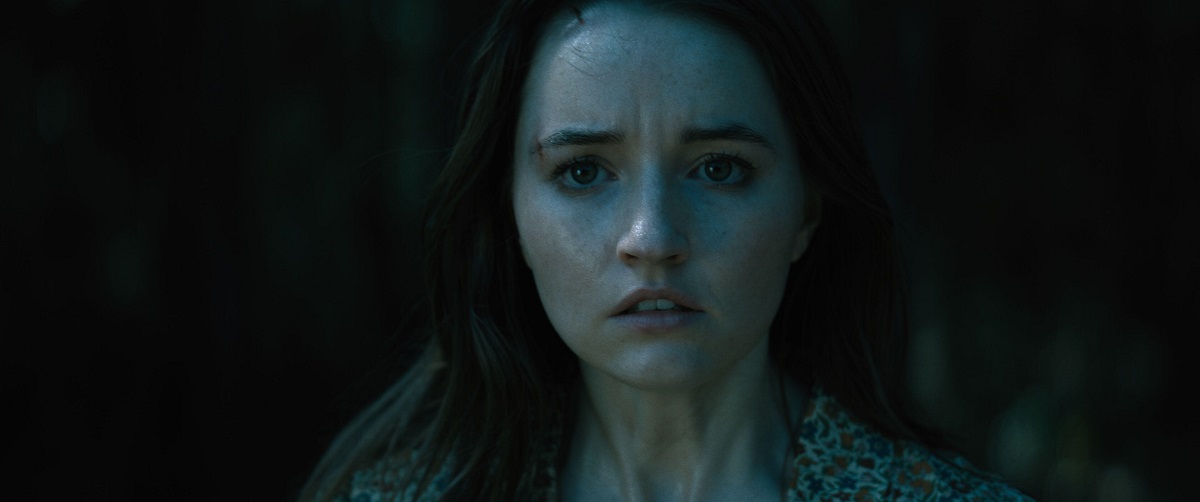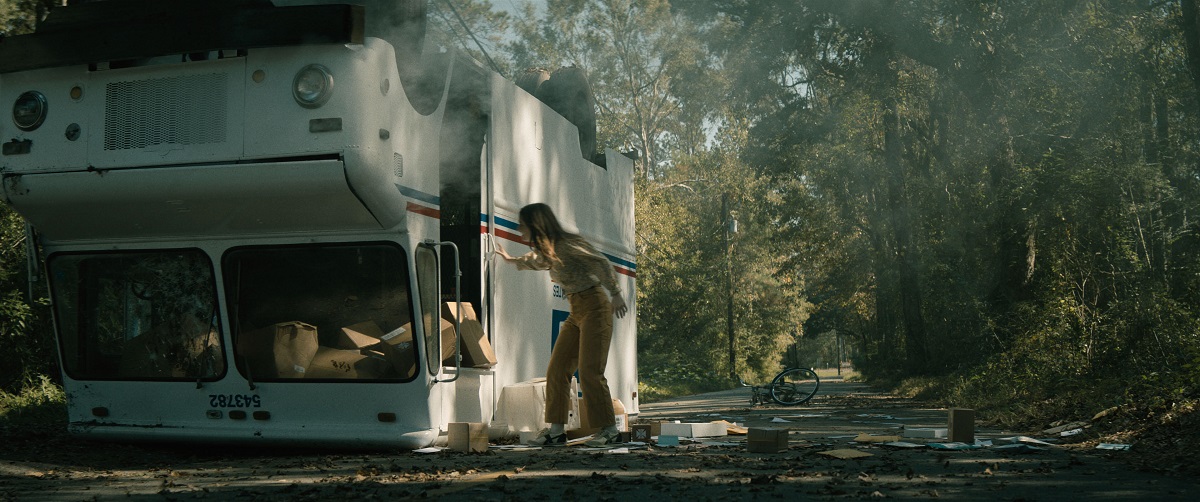TL;DR
- Hulu’s sci-fi horror hit “No One Will Save You” is virtually dialogue-free, but the filmmakers aimed not to draw attention to that device while still being aware of how much extra weight the visuals needed to carry.
- The most challenging aspect of the shoot for cinematographer Aaron Morton was lighting the aliens with moving lights more commonly found at rock concerts.
- Lighting of the color red in particular played into the production’s choice of Sony VENICE camera.
Home invasion movie No One Will Save You can be added to the low budget horror film renaissance (think Huesera: The Bone Woman, Barbarian, M3GAN, Talk To Me) and the most streamed film across all platforms in the US when it was released last month.
Made for $22.8 million, the Hulu original is an almost wordless thriller in which Brynn (played by Booksmart’s Kaitlyn Dever) is a young woman living alone as a seamstress in the countryside fights back against alien invaders.
“He didn’t tell me about the lack of dialogue before sending me the script,” says cinematographer Aaron Morton (Black Mirror: Bandersnatch; The Lord of the Rings: The Rings of Power) of receiving the project from writer-director Brian Duffield. “Reading it for the first time it dawns on you.
He adds, “It sounds counter-intuitive given the lack of dialogue, but the way the script conveyed the tension and terror that the character’s feel did so much work to help us understand the approach to this film.
“One phrase we had throughout prep was that horror can be beautiful. We tried to make a beautiful film that was scary.”
Duffield, who wrote 2020 monster adventure Love and Monsters and 2020 sci-fi horror Underwater, is drawn to ideas that smash two things together that don’t necessarily go together.
“We talked a lot about if Todd Haynes was making Far From Heaven and if aliens invaded in the middle of it what that would feel like,” Duffield commented on the set of No One Will Save You in the video featurette above.
It’s the kind of a thing he brings to a lot of his scripts, says Morton, a New Zealander who previously lensed a film for the director about teenagers spontaneously exploding.
“Spontaneous (2020) was really a lovely love story between two kids who happened to be in a situation where their friends are literally exploding next to them. Brian loves smashing two disparate situations together and seeing what comes of it.”
He continues, “What is clever about No One Will Save You is that while we are learning about what’s happening to the world in terms of the alien invasion we’re also being drip fed information about Brynn’s character and what has happened to her in her life.”
While the script has somewhat of a conventional narrative driver from set piece to set piece, what’s missing from more traditional film is coverage — the over the shoulder, reverse shot grammar of two people having a conversation.
“We’re still using filmmaking conventions but making sure we have an awareness all the time that we were ticking the boxes for the audience in terms of what they were learning about story and character,” Morton explains.
“We knew we didn’t want to treat the lack of dialogue as a gimmick. It was just a by-product of the situation that Brynn found herself in. Our aim was not to draw attention to that device in the movie while being very aware of how much extra weight the images needed to carry in a ‘show, don’t tell’ sort of way. The nature of the film relies on the pictures doing a little bit of extra work.”
The most challenging aspect of the shoot for Morton was lighting the aliens. “The light is part of how they control humans,” he says. “We definitely wanted to be reminded of Close Encounters which did inspire a lot of what we were doing in our movie.”
This includes leaning into the classic tractor beam trope of being sucked into the mothership. They were lighting some reasonably large areas of swamp and night exteriors of Brynn’s house, often using cranes with moving lights. These were powerful Proteus Maximus fixtures from Elation Lighting, more commonly found at rock concerts.
“The moving alien lighting is built into the exterior night lighting. For instance, when Brynn is walking up the road in a forest, the forest is lit and suddenly a beam is on her and she gets sucked up into spaceship. We had the camera on a crane, and we had ambient ‘forest’ lighting on a crane so I could move that ambient lighting with her as she walked. We had another crane with the big alien light that stops her in her tracks. So it was this ballet of things happening outside the frame.”
He continues, “I love using moving lights (combined with the right sensor) because you can be so accurate in changing the color temp by a few degrees, even putting in Gobos to change the beam size, using all the things moving lights are great for in live events and putting them into the cinema world.”
The lighting design also gave the filmmakers another way to show the audience things that Brynn does not see. “She could leave a room and just as she turns away we play a light across a window just to remind people that the aliens are right there though she’s not aware of it.”
Since the color red plays a particularly important role in depicting the alien presence, Morton tested various cameras before selecting the Sony VENICE.
“You can quickly over-saturate red, green and blue colors with certain cameras, so it’s a big piece of puzzle that you can figure it out early. We felt the color science of the VENICE was incredible in terms of capturing that red.”
They shot anamorphic using a set of Caldwell Chameleon Primes. “What I also like about the VENICE is that you can chop and change the sensor size. The Chameleons cover the large format size very well but not perfectly so it meant I could tailor which part of the sensor we were using depending on which lens we were on.”
Elaborating on this he says, “You can very easily go from a Super 35 size 4K sensor on the VENICE to 6K using the full horizontal width of the sensor so sometimes, if I needed a bit more width in the room in a certain situation and what we were framing was forgiving enough, I could use a wide lens in 6K mode and not worry about the distortion we were getting because we’re using every inch of the image circle.”
The production shot in New Orleans but is not location specific. “It’s Generica,” says Morton, who commends the Louisiana crew.
“We ran three camera bodies all the time with two full teams so we could be shooting with two and prepping another camera then leapfrogging one to the next.”
Morton has somewhat of a horror film pedigree having photographed 2013’s Evil Dead remake, the “Metalhead” episode of Black Mirror (arguably the series’ bleakest story) and The First Omen, directed by Arkasha Stevenson for 20th Century Studios starring Bill Nighy, which is scheduled for imminent release.
He was in the middle of shooting a feature for Universal in Dublin when the strikes hit and still has three weeks of work on that project to complete, for which he is using a package of Alexa 35 and Cooke S4 sphericals.
“I love going job to job to approach with fresh eyes and be given a clean slate. Whilst I welcome giving my opinion on what approach would work I’d much rather have a two-way back and forth with a director about what they think so we can get the best story to screen.”
Reaction
With a big full-orchestra score from Joseph Trapanese, “Duffield admirably trying to turn his Hulu budget into Amblin production value,” reviewed Benjamin Lee at The Guardian. “It’s got the feel of a real movie, the highest compliment one can give right now to a film designed for streaming.”
READ MORE: No One Will Save You review – almost wordless sci-fi thriller loses the plot (The Guardian)
Forbes critic Mark Hughes said, “The film is expertly paced and gets endless mileage from its premise. It’s one part Signs, one part Body Snatchers, and a whole lot of Cronenberg, all of which I love independently and am thrilled to see combined here.”
He adds, “the largely dialogue-free approach might sound gimmicky or distracting, but it’s neither and highlights how well written, directed, and performed the whole thing is.”
READ MORE: Review: ‘No One Will Save You’ Is The Best Horror Film Of 2023 (Forbes)
Others were more negative. Here’s Sam Adams at Slate: “[It] could have been a spectacularly scary short film. Instead, it’s a movie that starts off with an incredibly strong premise and sense of itself, and then squanders nearly all of it in a scattershot middle and confounding conclusion.”





